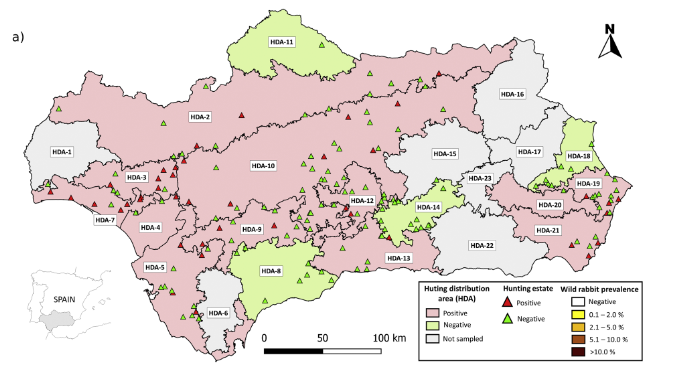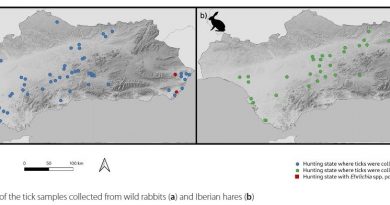Spatiotemporal monitoring of Cysticercus pisiformis in European wild rabbit (Oryctolagus cuniculus) in Mediterranean ecosystems in southern Spain
Preventive Veterinary Medicine
Abstract
Cysticercosis in wild lagomorphs is caused by Cysticercus pisiformis, the larval stage of Taenia pisiformis. Although previous studies have reported the presence of T. pisiformis in different wild carnivore species, information about the prevalence of C. pisiformis in their intermediate hosts is still very scarce. An epidemiological surveillance program was carried out to determine the prevalence and spatiotemporal patterns of cysticercosis in wild rabbits (Oryctolagus cuniculus) from Spanish Mediterranean ecosystems. A total of 2,923 animals were sampled in 164 hunting estates from Andalusia (southern Spain) during four study periods: 2009−2012 (P1), 2012−2015 (P2), 2015−2018 (P3) and 2018−2020 (P4). The presence of cysticerci was assessed by macroscopical examination and a subset of the collected parasites were molecularly identified by conventional PCR targeting the ITS-1 and 12S rRNA partial genes of Taenia spp. Risk factors associated with cysticercus infection were assessed by generalized estimating equation (GEE) analysis. A spatial statistical analysis was carried out using a Bernoulli model to identify statistically significant spatial clusters. Cysticercus infection was confirmed in 81 (2.8 %; 95 % CI: 2.2–3.4) rabbits. Cysticerci from 18 infected animals were molecularly identified as T. pisiformis. The GEE model showed the study period as the only risk factor associated with C. pisiformis infection in wild rabbits. Significantly higher prevalence was found in P2 (6.1 %; 95 % CI: 4.4−8.4) compared to the rest of the periods. At least one cysticerci-positive animal was detected in 41 (25.0 %; 95 % CI: 18.4–31.6) out of the 164 hunting estates. No statistically significant spatial clusters of high cysticercus prevalence were identified. Our results indicate an endemic circulation of C. pisiformis in wild rabbits in southern Spain. The spatial results highlight a widespread distribution of this parasite in their populations. Further studies should focus in determining which sympatric species may act as definitive hosts for T. pisiformis and the relevance of other potential intermediate host species (e.g. hares and rodents), as the relevance of wild rabbits in the sylvatic cycle of this cestode in Mediterranean ecosystems seems to be low.




